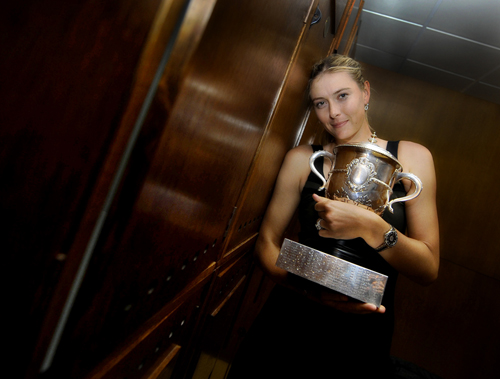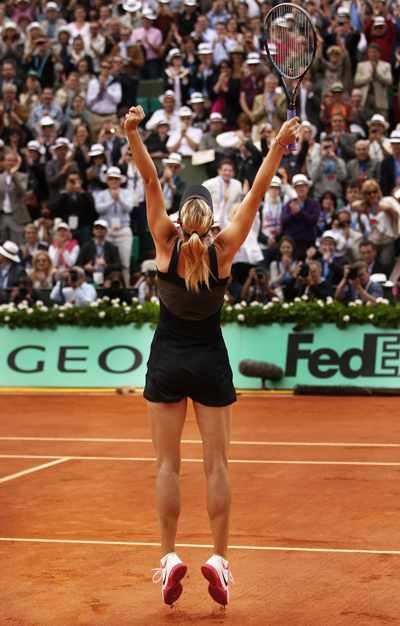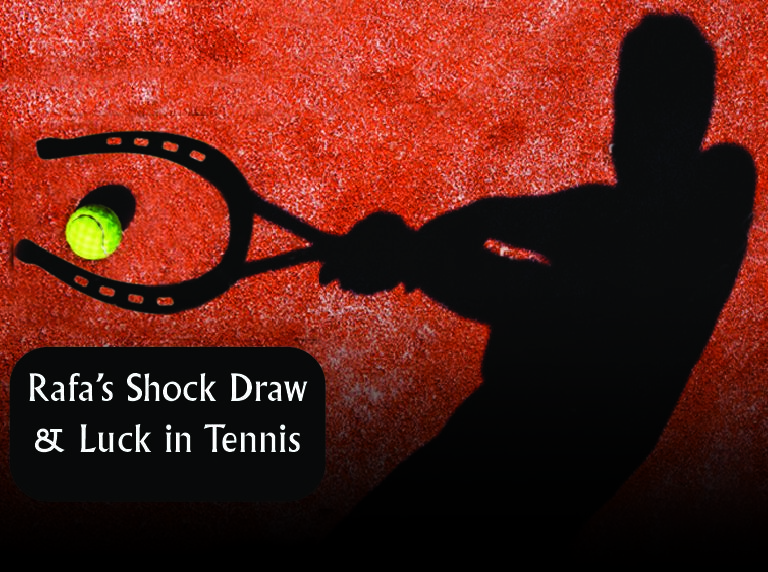“You Achieve Great Things When You Don’t Listen”
PARIS – There is little debate about her back story. Lucky to survive the debacle of Chernobyl, Maria and her gruff dad Yuri left Siberia for the Bollettieri tennis factory in Florida with $700 and “a racket bag and a suitcase full of prayers.” She quickly learned to bash deep flat groundies and, at just 17, she called on that mental toughness (“that would not shame a KGB agent”) and beat Serena to win the ‘04 Wimbledon. Everyone – from Trump and Letterman to baseliners in Slovokia – were impressed.
There was no doubt this supermodel beauty was much more than a backhand and a grunt. She could play. She became No. 1 in ’05 and won the U.S. Open in ’06 and ’08. And she was hot. She not only was on countless covers, she inked deals with Tiffany, Canon and Land Rover, plus a nifty $70 million Nike contract. Some bristled. “What girls like Sharapova want to do is to sell at any cost,” said former Wimbledon Champ Conchita Martinez. “I’d save my bikini wearing for the beach.”
Yes, Sharapova would play wearing $400,000 earrings and in outfits with 700 Swarovski crystals. She was no stranger to runways and there were soirees from Manhattan to Manhattan Beach. But Sharapova was not just a pretty face . Sure, she confided, “beauty sells, I’m not going to make myself ugly … [but] being a tennis babe doesn’t make if for me.”
But the true test of her convictions came in ’08 when a serious shoulder injury sidelined her. She could have retired right there – no shame. And no tennis player has ever come back from the Tommy John surgery she had. But Sharapova is nothing if not fiercely determined. Siberia will do that to you.
So Maria trudged on a long and winding rehab road. Every week there were Southwest flights from L.A. to the gym and a shoulder specialist in Phoenix. The pretzels were stale, the routine was brutal, the results were slow. Her ranking plummeted to No. 126. But she did emerge on tour in ‘09 where the Maria debate was renewed.
The issue wasn’t so much whether her screeching grunt was an unfair hindrance. It wasn’t whether – with her haughty and aloof ferocity – it was better to call her devastating stare an evil eye or an icy glare?
It was more about the tour, her game and her athleticism. After all, as four years passed and the double faults mounted, she was still in the WTA mix, but not in the Grand Slam winners circle. Was her once-powerful serve now a weapon of the past? Would a new generation of gifted wannabes sweep aside this proud lady and ultimately, for all her will and ball-striking brilliance, was she more of a stroke-meister than an athlete?
Writer Simon Barnes suggested, “There is a strange kind of awkwardness about Sharapova … She’s a rare mixture of grace and clumsiness, like a young horse that forgets how to count to four in legs.” Forget the horse bit. Sharapova famously said that on clay, she was like “a cow on ice.” There was good reason that the French Open – the major that most demands athleticism – was the one Slam she had never won.
But Sharapova was trending in the right direction. She finished 2011 at No. 4 and was having a grand, if at times frustrating, 2012. Coming into Paris she had reached but lost in three big finals – the Australian Open, Indian Wells and Miami – while she won in Stuggart and defended her title in Rome. Amazingly, she was 15-0 going into the final on red clay and four of her last five titles were on the slow sticky stuff.
Still the debate went on. Cynics noted that virtually all of her great opponents had vanished in Paris. Serena Williams, who had crushed her on the blue clay in Madrid, lost in the first round. Victoria Azarenka, who dismissed Maria in the Melbourne and Indian Wells finals, fell in the fourth round. Li Na, who nearly dethroned her in Rome and Agnieszka Radwanska, who beat her in Miami, were also gone.
The Red Sea opened.
Maria crossed.
She crushed her first three foes, losing just five games. But then there was a hiccup. In the fourth round her served collapsed against Czech Klara Zakopalova. Still she survived 6-4, 6-7 (5), 6-2 and marched onto the Roland Garros final as she set aside two tough Euro battlers – Estonian Kaia Kanepi and Petra Kvitova, who had beaten her in the Wimbledon. Maria was now poised. The debate would be over. Sharapova could win her first Slam since her injury four years ago; her first French Open title and become just the sixth woman of the Open era to claim a career Slam.
***
To err is human, but to be (Sara) Errani this Spring has been divine.
Without doubt, the Bologna native who is the daughter of a fruit and vegetable salesman gave tennis plenty of food for thought.
Just 5’ 4” and little known, she captured the French Open doubles title with her fellow Italian Roberta Vinci. Smart, swift, crafty and clay savvy, the expressive veteran had won three small clay tourneys this year and in Paris marched past three Grand Slam winners: Ana Ivanovic, Svetlana Kuznetsova and, in the semis, the player some claim is the best clay courter in the world, Sam Stosur.
Like Sharapova she was a 25-year product of the Bollettieri Academy who now was in the French final. But this was her first major final. It was Maria’s sixth. Errani gave away eight inches. She was seeded No. 21, and no one with such a low seed had ever won Roland Garros. Previously Errani had never gone beyond the third round at Roland Garros and in 28 tries had never beaten a top ten player. Already this year Sharapova had eight wins over top ten players. Worse yet, Errani’s weakest shot, her serve, was a set up against Sharapova’s best – her return.
So on this sometimes sunny Paris Saturday, we had a small, heady, mid-ranked clay court scrapper who, in the showing of her life, reached the finals. There she would confront the savvy Sharapova who (with Serena) is toughest mentally of the era and who is gifted with an imposing first strike game. Maria started fast, served well and left little in doubt as she went for her shots, ran better than ever, showed her strength, returned with a predictably merciless power and dealt with Errani’s deft drop shots. She played with an unflinching – just another day at the office – belief.
Simply the better player, Maria kissed the lines with both her flat, fierce groundies before she blew kisses to the crowd. After just 1:29, the 6-3, 6-2 winner dropped to her knees, her head in her hands. She turned to her friends box. Oh-my-God, she said, what did I just do. Tears fell and she rose (like Venus once did at Wimbledon) and jumped in Zulu-like leaps of glee.
And there was no more debate.
Yes, she will concede she’s a Princess. So what. The WTA at last again has royalty at the top. A true superstar was back. The freshly crowned French Open Champ and the holder of a career Grand Slam was No. 1. And any recollections of troubled times in Siberian outback, poverty in Florida or stale pretzels on Southwest were just distant memories.
Instead, Sharapova – now so thoughtful and appreciative – put her moment, her craft and her love of her game in perspective.
In a stunning post-match reflection she said, “It’s surreal. It’s the most unique moment I’ve experienced in my career. I never thought I would have that. … When I won Wimbledon at 17, I thought that would be the most treasured moment of my career. But when I fell down on my knees today I realized that this was extremely special, and even more so. Yeah. It’s a long journey. It started from a very young age. It’s not over yet … I have a lot more in me to achieve. I believe in my game. That’s one of the reasons why I’m sitting here … because I always believed I could be better … whether it was on clay, whether it was on grass, whether it was on cement, anything … And one percent here, a few here, this is what I’ve always wanted to achieve. No matter how tough it was, no matter how many people didn’t believe in me, … I didn’t care and I didn’t listen. I always listened to my own voice, and it always told me that for some reason I’m meant to be better. I’m meant to succeed again.
“And I did … I proved that no matter how many punches I took in my career, I’ve always gotten back up. I never made excuses for me, not to myself, not to people. I always relied on my own talent, on the help of my team … I have a tremendous amount of belief and pride in what I do. I love my work. I’ve always said this: I love playing tennis.
“I had so many outs in my career. I could have said, I don’t need this. I have money; I have fame … I have Grand Slams. But when your love for something is bigger than all those things, you continue to keep getting up in the morning when it’s freezing outside, when you know that it can be the most difficult day, when nothing is working, when you feel like the belief sometimes isn’t there from the outside world, and you seem so small. But you can achieve great things when you don’t listen to all those things.”




















